Car hesitates when accelerating from stop or when driving uphill is truly frustrating, and it can be dangerous in certain situations like entering and exiting the highway, where acceleration might be necessary to merge with traffic.
This happens generally because your engine is not generating enough power to facilitate the increase in speed, however, the exact culprit can require some time and knowledge to pinpoint.
This article includes a comprehensive list of 11 common reasons why for car hesitates when accelerating. Move from each to rule out one by one the actual culprit and perform the required replacement or maintenance to enjoy smooth and safe driving.
Contents
Car Hesitates When Accelerating From Stop: 11 Common Reasons
In essence, delay or hesitation of the engine during acceleration happens when the engine does not get enough power, and it needs more power to accelerate from a dead stop than when maintaining the speed of a moving vehicle.
The engine generates power by creating combustions in its chamber. The input for such combustions, or explosions, is a mixture of air and fuel at a fixed optimal ratio, which is ignited by the spark plug.
The engine houses multiple cylinders, and combustions take place in these cylinders in a continuous order so that a continuous supply of energy is generated to run the engine.
Therefore, if there is any issue with any of the engine components that control such a mechanism for igniting the fuel and airflow supply, the engine will not get enough power when needed, thus making the car hesitate when accelerating from stop.
The reasons for this issue can be quite a long list. Inspect the following components in turn when you experience the issue of car slow to accelerate after stopping.
The air filter
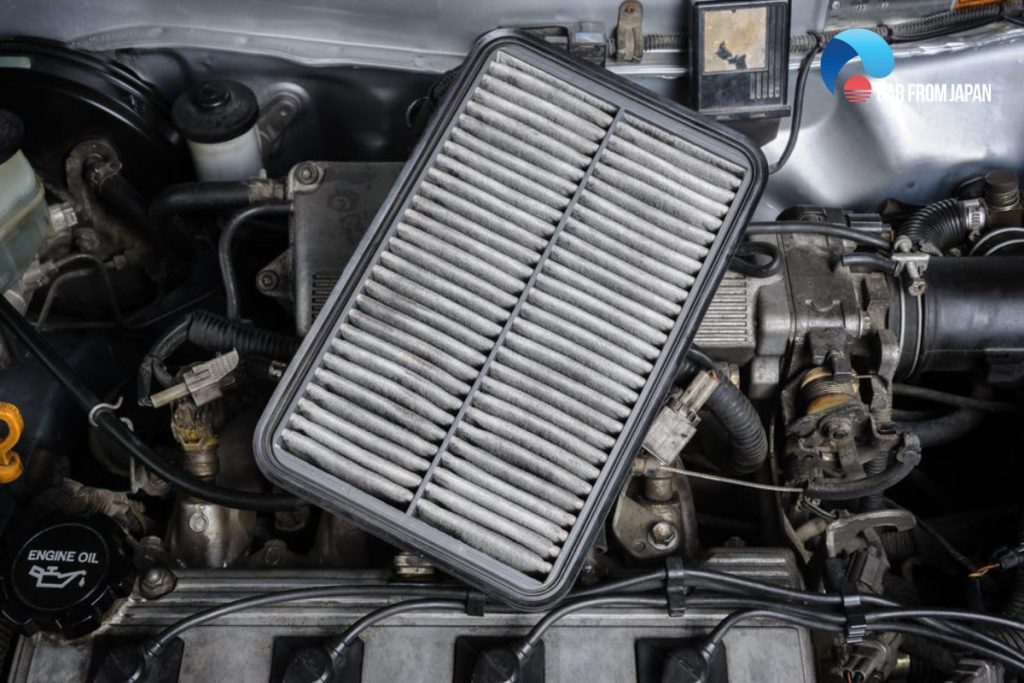
One of the most common reasons that makes your car hesitate when accelerating from a stop, and the easiest one to fix, is a dirty air filter.
Your engine needs a constant supply of air to run, and the air part of that equation can be affected quite a bit if the air filter is dirty and clogged with dust buildup.
A clogged air filter means the engine will not get enough air to produce optimal combustion, thus generating less power than what is needed to accelerate the car.
If prolonged, this small problem will smother the engine and negatively affect fuel economy as well as your driving experience and safety.
Fortunately, if this is the culprit, you simply need to take the air filter out of the air box , inspect it, and replace it with a new one.
Mass airflow sensor
This is the next component to inspect after you’ve ruled out the air filter.
The mass airflow sensor keeps track of the volume of air entering the engine and reports the information to the ECU (Engine Control Unit). The computer uses that information to decide the corresponding amount of fuel the fuel injectors should deliver.
A failing or stuck sensor relays the wrong information, so the engine does not get the correct amount of fuel it needs, resulting in suboptimal energy generation and thus will cause the car to hesitate during acceleration from a stop or while driving uphill.
Do note that if the mass airflow sensor is the reason, it may or may not trigger a trouble code.
Fuel pump
While your engine needs air and fuel to be injected into the combustion chamber, fuel is stored in the fuel tank.
Therefore, a fuel pump, also referred to as a “fuel transfer pump”, is needed to transfer gasoline or diesel from the fuel tank to the engine, specifically to the carburetors or fuel injectors, depending on the type of vehicle you have.
The carburetors or fuel injectors then disperse fuel into the combustion chambers of the engine.
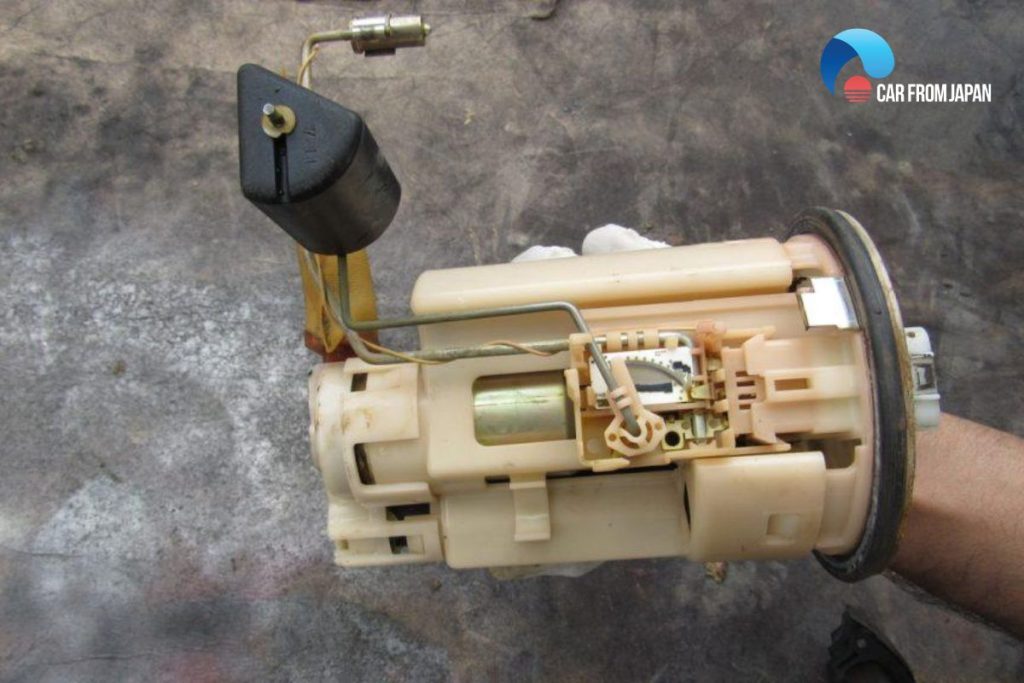
It goes without saying that when the fuel pump in your vehicle malfunctions, the engine will not get the correct amount of fuel at the right time, thus its performance will be impeded.
A dirty or damaged fuel pump can trigger a handful of issues. A clogged or faulty fuel pump means the engine is not getting enough fuel at a given time to generate enough energy, thus making the car hesitate when accelerating from stop.
Read More: How To Start A Car With A Bad Fuel Pump
Fuel injectors
As stated above, after the fuel pump transfers fuel from the fuel tank to the engine, the fuel injectors then spritz fuel into the cylinder. The fuel then gets mixed with air at a certain ratio and then gets ignited by a spark plug to create combustion.
Like the air filter and fuel pump, the fuel injector is also prone to accumulating dirt and sludge over time, which affects its capacity to supply the correct amount of fuel for the combustion.
As a result, the engine fails to produce enough power to take off smoothly after a dead stop.
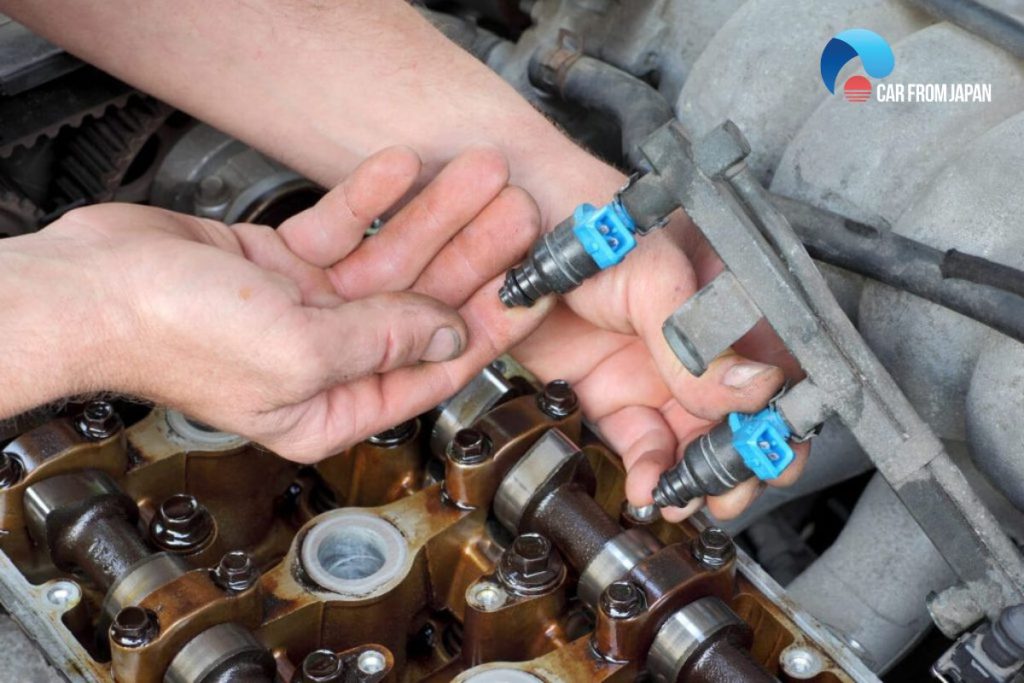
Fuel filter
Similar to the air filter, the fuel filter is prone to becoming dirty or clogged. This problem can cause loss of power or even a no-start condition, as the engine doesn’t receive enough fuel at a given time for optimal performance.
It can also make your car hesitate when accelerating from stop or when the vehicle is heading up an incline. Suboptimal engine performance of course will also result in poor fuel economy.
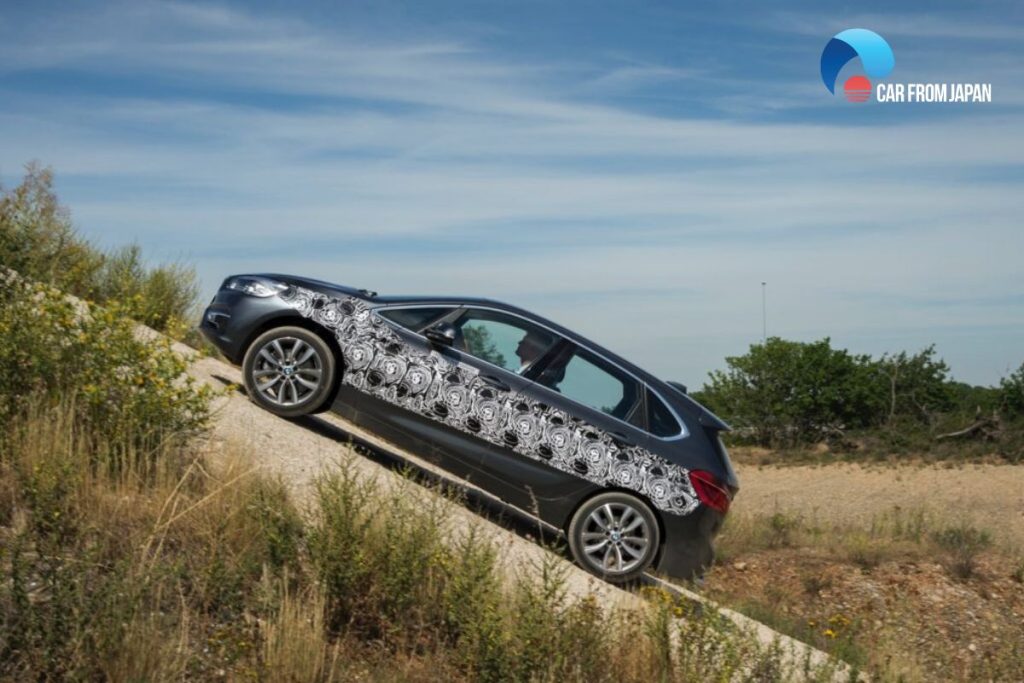
The fuel filter is located in the fuel tank on most newer vehicles and will require a trip to the shop for inspection if you’re not familiar with handling it. If your vehicle has an external fuel filter, it’s straightforward and inexpensive to replace it.
The accelerator pump
If you are driving an old vehicle with a carburetor, it must have the accelerator pump. The lagging could be the result of the pump being worn out or needing a fix.
It is a plunger rod with a rubber-sealed piston that squirts a small amount of raw gas into the carburetor. The surge of fuel and air triggers the engine to be more responsive to acceleration.
When the rubber seal gets worn out, it sends a large volume of air with little or no gas to the plunger cylinder. As a result, the car hesitates when accelerating from a stop. You have to replace the pump along with cleaning or replacing the fuel filter to fix the trouble.
Read More: Reasons for Engine Lagging During Speeding Up
Throttle position sensor
The throttle position sensor is a component of your car’s throttle body system. It is located between the engine’s intake manifold and the air filter.
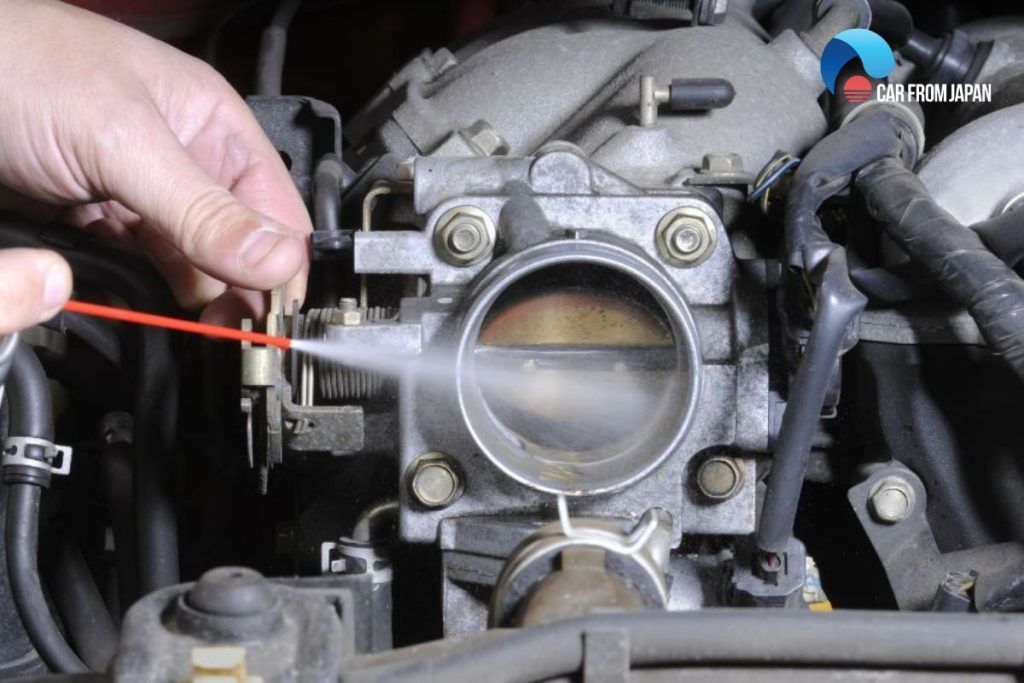
The job of the throttle position sensor is to make sure the engine receives the correct amount of air and fuel for optimal combustion.
Each time you press down on the gas pedal, the throttle butterfly valve rotates to let a precise amount of air enter through the engine’s intake manifold into the combustion chamber. As you press the pedal farther in, the valve opens more.
At the same time, the throttle position sensor sends out signals to the Engine Control Unit to report the position of the throttle butterfly valve.
Simultaneously, the ECU uses that information to adjust the amount of fuel to be instilled into the chamber at any specific time, creating the ideal conditions for the combustion to take place.
It is common for the throttle position sensor to malfunction since it consists of mechanical parts that may become worn and require replacement. A malfunctioning throttle position sensor will relay wrong data to your car’s computer.
A malfunctioning sensor won’t send the correct information, resulting in depriving the engine of enough fuel and air it needs to run smoothly when speeding up.
There are other signs that you can look for to make sure that a faulty throttle position sensor is the culprit. In most situations, when there is an issue with the throttle position sensor, the Check Engine Light will turn on.
Additionally, most carmakers supply a “limp home” mode of operation with decreased power if there is a failure in your engine. This is made to enable a driver to get off a crowded highway more safely.
If a faulty throttle position sensor is indeed the culprit that makes your car hesitate when accelerating from stop, you should have it inspected right away.
When your engine is not receiving the correct air-fuel ratio for proper function, it is working below optimal efficiency. The result is inevitably lower fuel economy and will cause damage to your engine, reducing its lifespan.
Read More: Bad Throttle Position Sensor Symptoms & How To Fix
Exhaust gas recirculation (EGR) valve
The role of the EGR valve is to recirculate exhaust generated during the engine’s combustion back into the combustion cycle to be burned, thereby reducing the engine’s temperature and lowering the production of poisonous nitrous oxide.
EGR valves open and close to control the gas flow. Over time, the exhaust builds up a hard and thick wall of carbon, locking the EGR valve open or closed.
This will block system passages and cause incorrect data to be sent to the engine computer, resulting in an incorrect amount of air and fuel being injected into the engine chamber, thus causing delayed acceleration.
A stuck or faulty EGR valve also increases emissions as well as the engine’s temperature, and a heated engine will never perform optimally or will not last very long.
The problem can over time lower your car’s mileage and shorten the lifespan of the engine. That’s why car manufacturers recommend cleaning the EGR valve and passages every 50,000 miles or fewer.
Coil pack

From the year 2000 onward, newer vehicles’ engines come equipped with a more advanced pack of ignition coils that sit directly on top of each engine cylinder’s spark plug to fire the plug directly. These coil packs are electronically controlled by the car’s engine computer.
Coil packs usually create a hotter and stronger spark, which in turn produces better combustion and horsepower in a car’s engine, compared to the older firing mechanism that requires an ignition coil, mechanical distributor, and plug wires.
Needless to say, when a coil pack starts to fail, it will affect the firing of spark plugs, thus impeding ignition and combustion.
Therefore, the engine will not generate enough power, making your car stall when accelerating from a stop, in rough-running conditions, or the engine stumbling and surging.
Fortunately, coil packs are easy to access and replace, usually requiring nothing more than a screwdriver or a small nut driver.
Oxygen sensor
The job of the oxygen sensors or O2 sensors is to monitor the oxygen content of the exhaust in proportion to the other gases and send this data to the engine control unit for emissions control and fuel-metering decisions.
This component is located in the exhaust stream, usually with one closer to the exhaust manifold and one further down the exhaust pipe.
In other words, the data from the oxygen sensor contributes to precise engine timing, combustion intervals, and correct air-to-fuel ratio.
Therefore, a failed O2 sensor will throw off fuel calculation and delivery, causing your engine to run rich, that is the engine is receiving too much fuel and too little air.
Such an incorrect air-fuel ratio will affect the engine’s ability to generate enough power to accelerate smoothly.
Another symptom of a failed O2 sensor is a strong smell of gasoline, especially when idling, and possibly an illuminated Check Engine Light.
FAQs on Car Hesitates When Accelerating
Why does my car hesitate only after refueling?
This could be due to a failing EVAP purge valve, which controls fuel vapors. If it’s stuck open, excess fuel vapors can flood the engine, causing hesitation or rough starts after refueling.
Why does my car hesitate when accelerating but not when reversing?
If hesitation only occurs in drive but not in reverse, it could indicate transmission problems, such as a failing torque converter or solenoid issues affecting forward gears.
Why does my car hesitate at a green light but then accelerate fine after a few seconds?
This could indicate fuel pressure problems. A weak fuel pump or clogged fuel filter may struggle to deliver fuel instantly but catch up after a moment, reducing hesitation once the car is moving.
Could my key fob battery affect my car’s acceleration?
Surprisingly, yes, for push-to-start vehicles. A faulty key fob battery can cause delayed communication between the key and the car’s ECU, sometimes leading to temporary throttle hesitation.
Watch this video from proclaimliberty2000 to learn how to fix the car hesitates when accelerating!
Final Words
By systematically investigating the potential causes outlined in this guide on car hesitates when accelerating from stop – fuel system, air intake, ignition system, and sensors – you can often pinpoint the root cause and take appropriate action.
For more insightful Car maintenance tips, follow Car From Japan!




i have a vw passat its doing the same thing it started when i cleaned the engine i used degreaser and water.after cleaning i started the engine and went for a test drive and it started loosing power and the silencer near the turbo charge heated and turned red.i went to a mechanic and he said it could be the catalyst and i got the catalyst removed but the jacking didnt stop so what could it be.